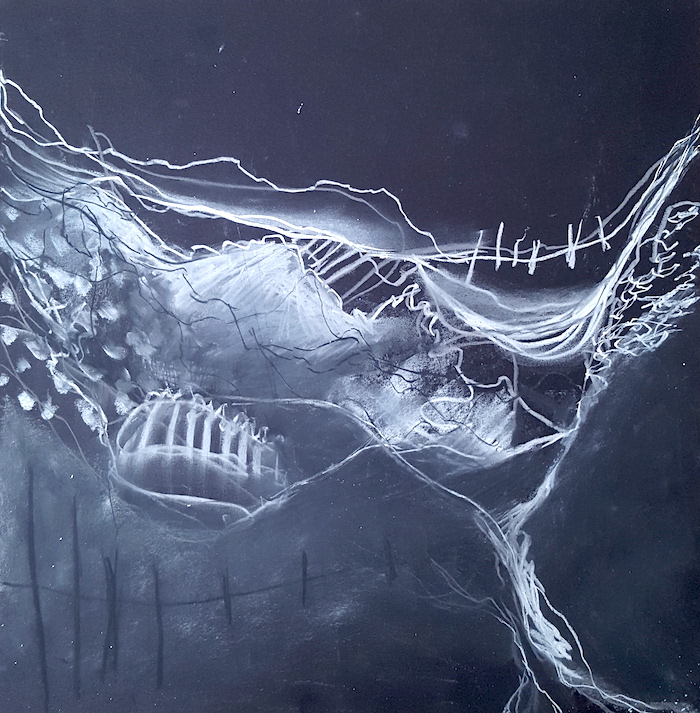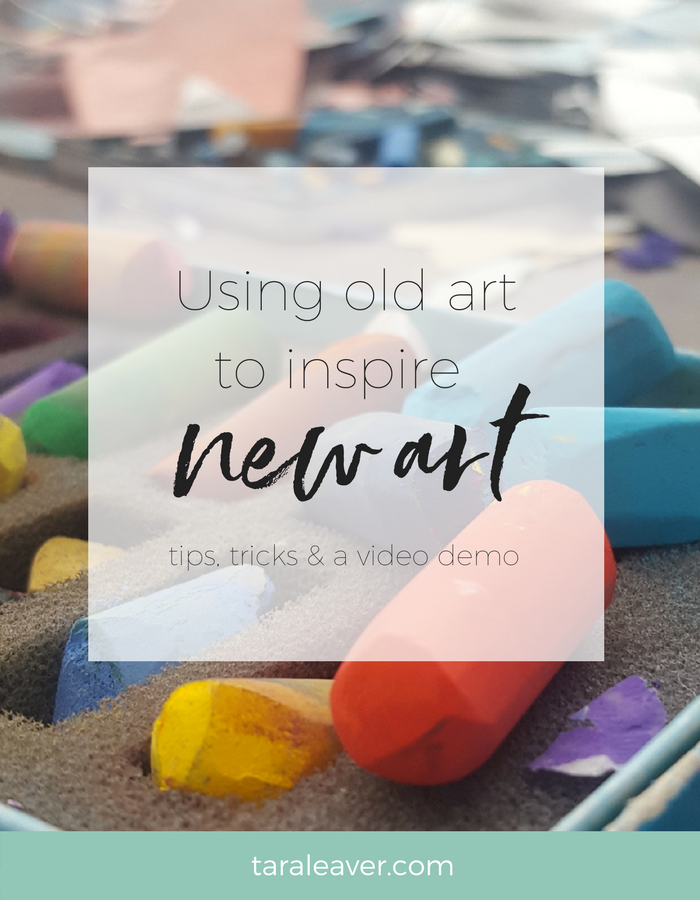If you’re in a bit of a painting rut, one very effective way to inspire yourself is with your own art. Most of us have, er, one or two previously made paintings and drawings stashed away, and using them as inspiration is a strong argument for keeping what you make. It’s also an excellent way to build on your own style and stay consistent. What’s not to love? 🙂
I recently used this approach myself, prompted by a studio clear out in preparation for my imminent move. I was sorting through piles and piles of old art, and singled out this white charcoal sketch on black paper.

Something about the lines and the composition pinged for me, so I decided to use it as a springboard for my next painting.
Tip: Old work is often unfinished, or monochrome {like sketches}, or otherwise ambiguous in terms of values and composition. For this reason I recommend using it as a jumping off point rather than trying to recreate it; this can quickly become stifling, and not everything scales up well. Keep reminding yourself that you can move things around, omit or add things, or, as I did, swap lines for collaged shapes to get started.
Below is a video I made of the entire process from start to {somewhat arbitrary} finish. You’ll see the painting changes quite a bit from the sketch that inspired it, and I’m happy about that. It was never meant to be a copy.
I like that I can take a piece of my own work, which carries my energy, and use it to generate new work which uses that energy but evolves and transforms it into something new, while still looking and feeling like me. It has a pleasing quality of integrity and self-propagation about it. 🙂
Things to note:
- The full video was an hour long {over several days}, so I’ve sped it up to about 20 minutes as we all have lives to lead. There are notes so you know what I’m doing and the thinking behind it as I go along.
- Because I was in the zone for quite a bit of it, I forgot I was filming and got in the way of the camera a few times. Sorry about that! But I didn’t cut anything out because the point is to see the entire process. If I only showed the tidy bits you’d miss the parts that we don’t always talk about – the mind changing, rubbing out, putting back, rubbing out again, trying stuff that doesn’t work etc. I want you to see that because it’s not just valid but essential to the growth of the painting.
- I added various tracks to accompany it; if they’re not to your taste it’s easy to mute them!
- Not shown: the long periods of nothing where I was standing back and contemplating it.
Materials used in the video:
- various acrylics, both ‘neat’ and mixed
- white gesso
- Liquitex matte medium with plastic palette knife
- Derwent XL charcoal {yellow ochre colour}
- Princeton Catalyst wedge
- willow charcoal
- Daler Rowney acrylic ink – orange, and yellow
- spray bottle
- Derivan liquid pencil
- Winsor and Newton soft pastel {my set is no longer available, however these are a reasonably priced substitute}
- cheap and basic baby wipes
{All affiliate links.}
If you have any questions about the process that weren’t addressed in the video please feel free to ask in the comments and I’ll help you as much as I can!








Thanks for this! I had recently been thinking that I’m faffing too much with my images instead of getting on with it, but now I know that I don’t faff nearly enough!
Also totally like the matte board test.
Haha, yes sometimes a lot more faffing happens than the finished result would suggest!
What is a catalyst wedge and where and why did you use it?
A ¡very! interesting video!!
I thought i “painted over” a lot but obviously more could be better. I think i keep too much bad stuff.
Hi Tommy – this is the Catalyst wedge I use: http://amzn.to/2uVA0N9. I enjoy how it moves paint around and creates translucent layers. They come with different edges for different effects. Glad you enjoyed the video!
Beautiful painting and process ! Will definitely use a viewfinder as you did! I didn’t know that trick… thanks Tara
Thanks Sophie! Lovely to see you here. 🙂 It’s a neat trick isn’t it.
The idea of recycling the old works for any creative effort really. I want to do that with my songwriting as well as painting. 🙂
Love that idea of using it for songwriting!
We’re on the same page. Last week I was scrolling through my own old art posts and I screen capped a handful because something about them made me want to revisit them as new inspiration.
And it was funny how YOU aren’t settled in at any point, until the “end”, but all during the video, those viewing (like me), are thinking “it’s great” all the way through.
Nice! I think sometimes we forget we have a wealth of inspiration already in front of us. 🙂 And yes, that’s partly why I like to share process as much as possible – there are so many places a painting might be called done, it becomes obvious that it’s a very arbitrary and personal thing, which I think frees things {us} up to be a bit more flexible and open.
Thank you, Tara, for video. It is realy amazing process. I don’t image how to use old works, I only made new painting over it. And your collage method is something incredible! Magic is here!
I paint over old works too. 🙂 But it’s nice to be able to develop new work from old and get that extra mileage from it. And thank you! 🙂
Thanks so much for sharing this video. It was incredibly interesting to watch the progression of this painting and kinda meditative too.
So glad to hear that Ellen!
I love seeing process examples like this one. It really shows that you can work without a clear plan of what it should be and how to get there. I’m going to give it a go next time I do an acrylic.
It’s good to have reminders of what’s possible sometimes I think. Glad you enjoyed it Linda!
You are such a generous and talented soul! This was fascinating.
Thanks Genie – glad you enjoyed it!
Thank you for this, Tara! It’s amazing to watch you work! Question – is this all on canvas? For some reason I have been very hesitant to put collaged paper on canvas. Do you typically do this?
Yes this one is on canvas. I have done this a lot although it’s easier on paper or wood panel, especially if you’re wanting to smooth out creases or put a lot of layers on, as obviously canvas can only take so much pressure or weight before sagging. You can pretty much do anything you want in art – you just have to try things and see how far you can push them. 🙂
Thank you I was stuck with a few nice but not necessary paintings and this has inspired me.
So grateful you are willing to share. Have taken workshops with artists afraid to show their painting process thinking it will be copied. Which I find ridiculous in that true artists just want to find their own style and find so much help from watching others. Not to copy ( why would a real artist want to ) but to learn. Thank you .
Yes I’ve come across that fear a lot, and I do understand it, but also agree with you and totally believe that what’s truly yours will eventually come through in its uniqueness if you keep at it. I think it’s really only lack of confidence that prevents people going beyond copying/heavy influence. We all want to be true to ourselves deep down.
Thank you so much for sharing your video. Really interesting and fascinating to see how you used your old painting to create new. Inspiring. Also great tip at the end to view find and check all areas are interesting! Many thanks!
Most welcome Lucille – glad it was helpful!